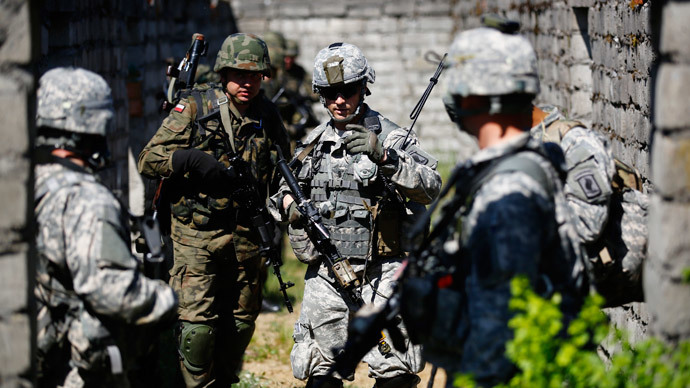
Paratroopers from the U.S. Army’s 173rd Infantry Brigade Combat Team participate in training exercises with the Polish 6 Airborne Brigade soldiers at the Land Forces Training Centre in Oleszno near Drawsko Pomorskie, north west Poland, May 1, 2014. IMAGE: Reuters / Kacper Pempel
On October 29th, Russian Deputy Foreign Minister Alexander Grushko said that unless NATO puts an end to the endless confrontation, a return to normal relations between the Alliance and Russia would be impossible.
“Today it’s obvious to us that if we return to the Russia-NATO relationship, there can be no restoration of normality unless NATO drops its current line of confrontation,” he said.
On October 26th, Russian Defense Minister Sergei Shoigu said that NATO military activity near Russia’s borders has reached a level that has not been seen since the Cold War. His comments were made regarding Trident Juncture 2018, the largest NATO drill since the Cold War, which began on October 25th and will continue through November 23rd. The exercise will play out an invasion of an allied country, in this case of Norway.
On October 29th, Germany began exercises off the Finnish coast involving 3,600 sailors and troops, 40 ships and 30 aircraft from more than a dozen countries. The maneuvers will focus on keeping crucial sea routes open in times of conflict.
The efforts by NATO and European Union naval forces, led by Germany are due to a reportedly increased Russian presence in the Baltic Sea area.
“The Baltic Sea is our front yard, so we and our neighbors obviously want to be able to move freely on the sea lines of communication,” Captain Sven Beck was cited by Reuters.
During the exercises, naval vessels will practice clearing mines from harbor entrances, escort cargo ships through contested waters and simulate using force.
“The aim of our exercise is to secure the sea lines of communication, those lines that you can’t see but that guarantee trade and prosperity in the countries along the Baltic coast,” Beck said.
As reported by Reuters, Russia has deployed missiles to its Kaliningrad enclave that can reach Berlin, NATO has thousands of troops in the region and Sweden, which is not a member of NATO, but an EU state is remilitarizing Gotland island.
Furthermore, according to Reuters, the shallow waters and narrow straits of the Baltic facilitate the laying of mines, while making it hard for warships to navigate. According to Western military experts Russia could block the free movement of NATO warships, making it impossible to support the tiny Baltic states in case of a war.
Moscow, in turn, says that it is not threatening any country and has the sovereign right to deploy weapons anywhere it sees fit on its territory. Kaliningrad is part of the country, despite its separate from the mainland and borders Poland and Lithuania. The Iskander-M missile launchers were positioned there in 2013. In February 2018, the head of the State Duma Defense Committee Vladimir Shamanov acknowledged that these weapons are stationed there permanently. According to Russia they were stationed there in response to the deployment of a US missile defense system, the AEGIS, which can potentially be repurposed to offensively launch nuclear missiles.
Germany is also building a new naval command center in Rostock. It is designed to house a permanent staff of international officers and if there is a crisis it would be able to lead NATO and EU forces in the Baltic starting from 2023.
This is also likely another step by Germany undertaken to please US President Donald Trump, who has criticized the country of spending too little on defense. According to him Germany should play a bigger military role in the Baltic region tensions.
German Defense Minister Ursula von der Leyen said in September that as the biggest NATO and EU country on the Baltic, Germany must “take more responsibility for the region.” The country has been hesitant to take military lead post World War Two.
Other Western countries welcome the German initiative.
“We are very happy that Germany has taken the lead in that sense,” Finnish navy chief Admiral Veijo Taipalus said.
Meanwhile, over the entire month of October the US Ramstein Airbase in Germany received its biggest ammo shipment for almost 20 years. The last time such a major shipment was delivered to Ramstein was prior to Operation Allied Force in 1999, during which the US Air Force conducted some 900 air raids against then Yugoslavia.
Ramstein is the largest overseas US air base in the world and is used for many of its operations, such as drone strikes. Master Sgt. Arthur Myrick, 86th MUNS munitions flight chief, said that the shipment will be used to “support NATO’s European Deterrence Initiative (EDI) and augment the Air Force’s War Reserve Materiel in Europe.”
According to the airbase officials, the shipment is to also increase responsiveness and readiness of US forces by prepositioning ammunition, fuel and equipment to allow for a “rapid response against threats made by aggressive actors.”
“We’re a major airlift hub for U.S. Air Forces in Europe-Air Forces Africa, so our main job is to get munitions where they need to be on time. These are real-world munitions to fulfill real-world objectives. That’s the reason we are downloading these things: to make sure we have the capability to move the fight forward if need be,” Myrick said.
It does appear that the New Cold War has, for all intents and purposes, already began, with the US leaving the INF and even considering also leaving the new START Treaty. Constant claims of Russian aggression and misconduct are being fed mostly by the US government to the MSM. The narrative is then turned into a media hysteria. Despite that, the US conduct appears to be causing a regionalization of the world, which in turn hinders its bid for global dominance.





